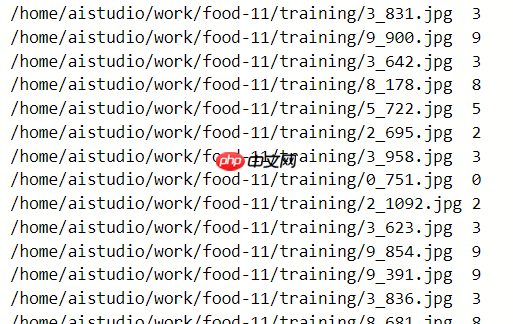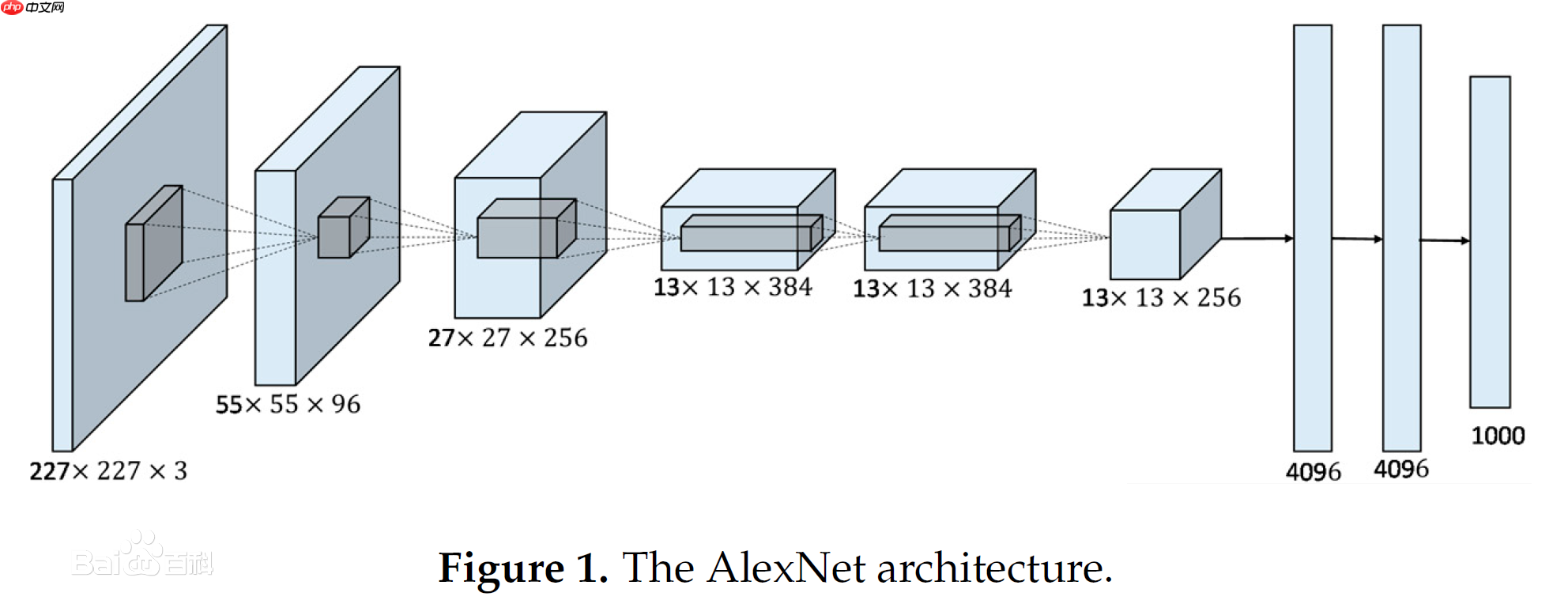该项目用PaddlePaddle训练CNN实现food-11数据集的11类食物分类。先解压含训练、验证、测试集的数据集,制作标签文档,继承Dataset类生成数据集。构建含3个卷积层、池化层等的CNN,用Adam优化器等训练,训练5轮后保存模型,最后测试单张图片,虽准确率不高但跑通流程。
☞☞☞AI 智能聊天, 问答助手, AI 智能搜索, 免费无限量使用 DeepSeek R1 模型☜☜☜

训练一个简单的卷积神经网络,实现食物图片的分类。
本次使用的数据集为food-11数据集,共有11类
Bread, Dairy product, Dessert, Egg, Fried food, Meat, Noodles/Pasta, Rice, Seafood, Soup, and Vegetable/Fruit.
(面包,乳制品,甜点,鸡蛋,油炸食品,肉类,面条/意大利面,米饭,海鲜,汤,蔬菜/水果)
Training set: 9866张
Validation set: 3430张
Testing set: 3347张
数据格式 下载 zip 档后解压缩会有三个资料夹,分别为training、validation 以及 testing
training 以及 validation 中的照片名称格式为 [类别]_[编号].jpg,例如 3_100.jpg 即为类别 3 的照片(编号不重要)
实现方式
paddlepaddle
说明:
本项目素材和内容源于李宏毅老师课程,但是是使用飞桨实现的!
本项目仅仅是跑通了,对于准确率没有要求和细细琢磨,仅供参考!
# !unzip -d work data/data75768/food-11.zip # 解压缩food-11数据集
import paddleprint(f'当前Paddle版本:{paddle.__version__}')当前Paddle版本:2.0.1
import osimport paddleimport paddle.vision.transforms as Timport numpy as npfrom PIL import Imageimport paddle.nn.functional as F
data_path = '/home/aistudio/work/food-11/' # 设置初始文件地址character_folders = os.listdir(data_path) # 查看地址下文件夹character_folders
['testing', 'validation', 'training']
data = '10_alksn'data[0:data.rfind('_', 1)] # 判断_位置并截取下划线前面数据'10'
# 新建标签列表if(os.path.exists('./training_set.txt')): # 判断有误文件
os.remove('./training_set.txt') # 删除文件if(os.path.exists('./validation_set.txt')):
os.remove('./validation_set.txt')if(os.path.exists('./testing_set.txt')):
os.remove('./testing_set.txt')for character_folder in character_folders: # 循环文件夹列表
with open(f'./{character_folder}_set.txt', 'a') as f_train: # 新建文档以追加的形式写入
character_imgs = os.listdir(os.path.join(data_path,character_folder)) # 读取文件夹下面的内容
count = 0
if character_folder in 'testing': # 检查是否是训练集
for img in character_imgs: # 循环列表
f_train.write(os.path.join(data_path,character_folder,img) + '\n') # 把地址写入文档
count += 1
print(character_folder,count) # 输出文件夹及图片数量
else: for img in character_imgs:
f_train.write(os.path.join(data_path,character_folder,img) + '\t' + img[0:img.rfind('_', 1)] + '\n') # 写入地址及标签
count += 1
print(character_folder,count)testing 3347 validation 3430 training 9866
训练集和验证集样式:
测试集:
# 测验下面类中__init__输出内容with open(f'training_set.txt') as f: # 查看文件内容
for line in f.readlines(): # 逐行读取
info = line.strip().split('\t') # 以\t为切换符生成列表
# print(info)
if len(info) > 0: # 列表不为空
print([info[0].strip(), info[1].strip()]) # 输出内容
break['/home/aistudio/work/food-11/training/2_1043.jpg', '2']
# 继承paddle.io.Dataset对数据集做处理class FoodDataset(paddle.io.Dataset):
"""
数据集类的定义(注释见上方)
"""
def __init__(self, mode='training_set'):
"""
初始化函数
"""
self.data = [] with open(f'{mode}_set.txt') as f: for line in f.readlines():
info = line.strip().split('\t') if len(info) > 0:
self.data.append([info[0].strip(), info[1].strip()])
def __getitem__(self, index):
"""
读取图片,对图片进行归一化处理,返回图片和 标签
"""
image_file, label = self.data[index] # 获取数据
img = Image.open(image_file) # 读取图片
img = img.resize((100, 100), Image.ANTIALIAS) # 图片大小样式归一化
img = np.array(img).astype('float32') # 转换成数组类型浮点型32位
img = img.transpose((2, 0, 1)) #读出来的图像是rgb,rgb,rbg..., 转置为 rrr...,ggg...,bbb...
img = img/255.0 # 数据缩放到0-1的范围
return img, np.array(label, dtype='int64') def __len__(self):
"""
获取样本总数
"""
return len(self.data)# 训练的数据提供器train_dataset = FoodDataset(mode='training')# 测试的数据提供器eval_dataset = FoodDataset(mode='validation')# 查看训练和测试数据的大小print('train大小:', train_dataset.__len__())print('eval大小:', eval_dataset.__len__())# 查看图片数据、大小及标签for data, label in train_dataset: print(data) print(np.array(data).shape) print(label) breaktrain大小: 9866 eval大小: 3430 [[[0.30588236 0.2509804 0.1882353 ... 0.19607843 0.19607843 0.19215687] [0.23921569 0.19607843 0.13725491 ... 0.19607843 0.1882353 0.18039216] [0.02352941 0.01176471 0.00392157 ... 0.19607843 0.18039216 0.1764706 ] ... [0.50980395 0.5137255 0.5176471 ... 0.5372549 0.5372549 0.52156866] [0.5137255 0.5137255 0.5137255 ... 0.5411765 0.53333336 0.5176471 ] [0.5176471 0.5137255 0.50980395 ... 0.52156866 0.5176471 0.5176471 ]] [[0.27058825 0.21568628 0.15294118 ... 0.00392157 0. 0. ] [0.20392157 0.14117648 0.09411765 ... 0.00392157 0. 0. ] [0.01568628 0.00784314 0.00392157 ... 0.00784314 0.00392157 0. ] ... [0.45490196 0.45882353 0.45882353 ... 0.4862745 0.47843137 0.4745098 ] [0.45490196 0.45882353 0.4627451 ... 0.47843137 0.46666667 0.46666667] [0.4509804 0.45490196 0.45882353 ... 0.47058824 0.46666667 0.45882353]] [[0.14509805 0.12156863 0.05098039 ... 0.00392157 0.00784314 0.00392157] [0.06666667 0.04313726 0.01960784 ... 0.00392157 0.00392157 0. ] [0. 0.00784314 0.00784314 ... 0.00784314 0.00392157 0.00392157] ... [0.33333334 0.32941177 0.33333334 ... 0.4 0.40392157 0.40784314] [0.32941177 0.32941177 0.32941177 ... 0.4 0.4 0.3882353 ] [0.3137255 0.33333334 0.3372549 ... 0.39215687 0.39607844 0.38431373]]] (3, 100, 100) 2

# 继承paddle.nn.Layer类,用于搭建模型class MyCNN(paddle.nn.Layer):
def __init__(self):
super(MyCNN,self).__init__()
self.conv0 = paddle.nn.Conv2D(in_channels=3, out_channels=20, kernel_size=5, padding=0) # 二维卷积层
self.pool0 = paddle.nn.MaxPool2D(kernel_size =2, stride =2) # 最大池化层
self._batch_norm_0 = paddle.nn.BatchNorm2D(num_features = 20) # 归一层
self.conv1 = paddle.nn.Conv2D(in_channels=20, out_channels=50, kernel_size=5, padding=0)
self.pool1 = paddle.nn.MaxPool2D(kernel_size =2, stride =2)
self._batch_norm_1 = paddle.nn.BatchNorm2D(num_features = 50)
self.conv2 = paddle.nn.Conv2D(in_channels=50, out_channels=50, kernel_size=5, padding=0)
self.pool2 = paddle.nn.MaxPool2D(kernel_size =2, stride =2)
self.fc1 = paddle.nn.Linear(in_features=4050, out_features=218) # 线性层
self.fc2 = paddle.nn.Linear(in_features=218, out_features=100)
self.fc3 = paddle.nn.Linear(in_features=100, out_features=11)
def forward(self,input):
# 将输入数据的样子该变成[1,3,100,100]
input = paddle.reshape(input,shape=[-1,3,100,100]) # 转换维读
# print(input.shape)
x = self.conv0(input) #数据输入卷积层
x = F.relu(x) # 激活层
x = self.pool0(x) # 池化层
x = self._batch_norm_0(x) # 归一层
x = self.conv1(x)
x = F.relu(x)
x = self.pool1(x)
x = self._batch_norm_1(x)
x = self.conv2(x)
x = F.relu(x)
x = self.pool2(x)
x = paddle.reshape(x, [x.shape[0], -1]) # print(x.shape)
x = self.fc1(x) # 线性层
x = F.relu(x)
x = self.fc2(x)
x = F.relu(x)
x = self.fc3(x)
y = F.softmax(x) # 分类器
return ynetwork = MyCNN() # 模型实例化paddle.summary(network, (1,3,100,100)) # 模型结构查看
--------------------------------------------------------------------------- Layer (type) Input Shape Output Shape Param # =========================================================================== Conv2D-1 [[1, 3, 100, 100]] [1, 20, 96, 96] 1,520 MaxPool2D-1 [[1, 20, 96, 96]] [1, 20, 48, 48] 0 BatchNorm2D-1 [[1, 20, 48, 48]] [1, 20, 48, 48] 80 Conv2D-2 [[1, 20, 48, 48]] [1, 50, 44, 44] 25,050 MaxPool2D-2 [[1, 50, 44, 44]] [1, 50, 22, 22] 0 BatchNorm2D-2 [[1, 50, 22, 22]] [1, 50, 22, 22] 200 Conv2D-3 [[1, 50, 22, 22]] [1, 50, 18, 18] 62,550 MaxPool2D-3 [[1, 50, 18, 18]] [1, 50, 9, 9] 0 Linear-1 [[1, 4050]] [1, 218] 883,118 Linear-2 [[1, 218]] [1, 100] 21,900 Linear-3 [[1, 100]] [1, 11] 1,111 =========================================================================== Total params: 995,529 Trainable params: 995,249 Non-trainable params: 280 --------------------------------------------------------------------------- Input size (MB): 0.11 Forward/backward pass size (MB): 3.37 Params size (MB): 3.80 Estimated Total Size (MB): 7.29 ---------------------------------------------------------------------------
{'total_params': 995529, 'trainable_params': 995249}model = paddle.Model(network) # 模型封装# 配置优化器、损失函数、评估指标model.prepare(paddle.optimizer.Adam(learning_rate=0.0001, parameters=model.parameters()),
paddle.nn.CrossEntropyLoss(),
paddle.metric.Accuracy())# 训练可视化VisualDL工具的回调函数visualdl = paddle.callbacks.VisualDL(log_dir='visualdl_log')
# 启动模型全流程训练model.fit(train_dataset, # 训练数据集
eval_dataset, # 评估数据集
epochs=5, # 训练的总轮次
batch_size=64, # 训练使用的批大小
verbose=1, # 日志展示形式
callbacks=[visualdl]) # 设置可视化The loss value printed in the log is the current step, and the metric is the average value of previous step. Epoch 1/5 step 155/155 [==============================] - loss: 2.5430 - acc: 0.1008 - 473ms/step Eval begin... The loss value printed in the log is the current batch, and the metric is the average value of previous step. step 54/54 [==============================] - loss: 2.5167 - acc: 0.1055 - 557ms/step Eval samples: 3430 Epoch 2/5 step 155/155 [==============================] - loss: 2.4430 - acc: 0.1008 - 473ms/step Eval begin... The loss value printed in the log is the current batch, and the metric is the average value of previous step. step 54/54 [==============================] - loss: 2.5167 - acc: 0.1055 - 559ms/step Eval samples: 3430 Epoch 3/5 step 155/155 [==============================] - loss: 2.4430 - acc: 0.1008 - 475ms/step Eval begin... The loss value printed in the log is the current batch, and the metric is the average value of previous step. step 54/54 [==============================] - loss: 2.5167 - acc: 0.1055 - 558ms/step Eval samples: 3430 Epoch 4/5 step 155/155 [==============================] - loss: 2.5430 - acc: 0.1008 - 474ms/step Eval begin... The loss value printed in the log is the current batch, and the metric is the average value of previous step. step 54/54 [==============================] - loss: 2.5167 - acc: 0.1055 - 560ms/step Eval samples: 3430 Epoch 5/5 step 155/155 [==============================] - loss: 2.4430 - acc: 0.1008 - 474ms/step Eval begin... The loss value printed in the log is the current batch, and the metric is the average value of previous step. step 54/54 [==============================] - loss: 2.5167 - acc: 0.1055 - 557ms/step Eval samples: 3430
model.save('finetuning/mnist') # 保存模型def openimg(): # 读取图片函数
with open(f'testing_set.txt') as f: #读取文件夹
test_img = []
txt = [] for line in f.readlines(): # 循环读取每一行
img = Image.open(line[:-1]) # 打开图片
img = img.resize((100, 100), Image.ANTIALIAS) # 大小归一化
img = np.array(img).astype('float32') # 转换成 数组
img = img.transpose((2, 0, 1)) #读出来的图像是rgb,rgb,rbg..., 转置为 rrr...,ggg...,bbb...
img = img/255.0 # 缩放
txt.append(line[:-1]) # 生成列表
test_img.append(img)
return txt,test_img
img_path, img = openimg() # 读取列表from PIL import Image
site = 255 # 读取图片位置model_state_dict = paddle.load('finetuning/mnist.pdparams') # 读取模型model = MyCNN() # 实例化模型model.set_state_dict(model_state_dict)
model.eval()
ceshi = model(paddle.to_tensor(img[site])) # 测试print('预测的结果为:', np.argmax(ceshi.numpy())) # 获取值Image.open(img_path[site]) # 显示图片预测的结果为: 0
<PIL.JpegImagePlugin.JpegImageFile image mode=RGB size=1024x683 at 0x7F5C383EA0D0>
以上就是paddle实现食物分类的详细内容,更多请关注php中文网其它相关文章!

每个人都需要一台速度更快、更稳定的 PC。随着时间的推移,垃圾文件、旧注册表数据和不必要的后台进程会占用资源并降低性能。幸运的是,许多工具可以让 Windows 保持平稳运行。

Copyright 2014-2025 https://www.php.cn/ All Rights Reserved | php.cn | 湘ICP备2023035733号